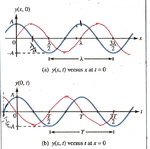Alan0354
Full Member level 4
A sine wave traveling in +x direction can be represented by \[\cos(\omega {t}- kx+\phi)\].
As shown in the drawing attached where \[ \phi=\frac{\pi}{2}\]:
a) Is a plot that holds t=0 and two waves along +x direction.
\[t=0\Rightarrow\; \cos(\omega {t}- kx+\phi)\;=\;\cos(- kx+\frac{\pi}{2})\]
This implies maximum at \[-kx+\frac{\pi}{2}\;=\;0\]
\[k=\frac{2\pi}{\lambda}\;\Rightarrow\; \frac {2\pi}{\lambda}x=\frac {\pi}{2}\;\Rightarrow\;x=\frac{\lambda}{4}\]
This gives the wave form in RED that LAGs the [itex]\cos(\omega{t}-kx)[/itex].
b) Is a plot of the waveform at x=0 and the two waves vary with time t.
\[ x=0\;\Rightarrow\; \cos(\omega {t}- kx+\phi)\;=\;\cos(\omega{t}+\frac{\pi}{2})\]
This implies maximum at \[\omega{t}=-\frac{\pi}{2}\]
\[\omega{t}\;=\;\frac{2\pi}{T}t\;=\;-\frac{\pi}{2}\;\Rightarrow\;t=-\frac{T}{4}\]
This means waveform in RED LEADs the original wave.
So the two cases give opposite result. Can anyone explain this to me?
Thanks
Alan
As shown in the drawing attached where \[ \phi=\frac{\pi}{2}\]:
a) Is a plot that holds t=0 and two waves along +x direction.
\[t=0\Rightarrow\; \cos(\omega {t}- kx+\phi)\;=\;\cos(- kx+\frac{\pi}{2})\]
This implies maximum at \[-kx+\frac{\pi}{2}\;=\;0\]
\[k=\frac{2\pi}{\lambda}\;\Rightarrow\; \frac {2\pi}{\lambda}x=\frac {\pi}{2}\;\Rightarrow\;x=\frac{\lambda}{4}\]
This gives the wave form in RED that LAGs the [itex]\cos(\omega{t}-kx)[/itex].
b) Is a plot of the waveform at x=0 and the two waves vary with time t.
\[ x=0\;\Rightarrow\; \cos(\omega {t}- kx+\phi)\;=\;\cos(\omega{t}+\frac{\pi}{2})\]
This implies maximum at \[\omega{t}=-\frac{\pi}{2}\]
\[\omega{t}\;=\;\frac{2\pi}{T}t\;=\;-\frac{\pi}{2}\;\Rightarrow\;t=-\frac{T}{4}\]
This means waveform in RED LEADs the original wave.
So the two cases give opposite result. Can anyone explain this to me?
Thanks
Alan
